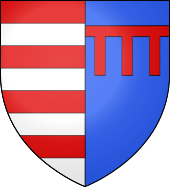Charles I (Hungary)
Charles I , histor.-traditional and Charles Robert (Hungarian .: Róbert Károly , kroat .: Karlo I. Robert ), originally Carobert (* 1288 in Naples ; † 16th July 1342 in Visegrád ) from the House of Anjou was King of Hungary and Croatia from 1308 until his death . He was the eldest son of the titular king Karl Martell and Klementia von Habsburg.
Life
He was baptized under the name Caroberto , but was crowned King of Hungary or King of Croatia as Karl I (his original name Carobert was not a compound word, but was mistakenly understood as a supposed double name "Karl-Robert" in later historiography; In the 19th century, this was mistaken for a first name and family name, and in Hungarian usage, where the family name is always mentioned first, it was reversed to “Robert Károly” - and thus additionally rendered meaningful). After the Arpaden died out in 1301, Charles, the first king of the House of Anjou, came to the Hungarian throne. His grandmother Maria , the wife of Charles II of Naples , was a sister of the penultimate Arpad king Ladislaus IV and considered herself to be the heir of Hungary. She transferred this title to Karl. In 1299 Pope Boniface VIII , who considered himself to be the liege lord of Hungary, confirmed this claim. However, the Hungarian nobility initially raised Wenceslaus III. on the throne. After his death in 1305, however, Karl succeeded in persuading the curia to renounce their feudal claim. At the same time, he was able to gain increasing recognition among the Hungarian nobles, sometimes by force, so that by 1308 he had largely prevailed against the counter-pretender Otto von Bayern .
Charles also had claims to the throne of the Kingdom of Naples as his father was the eldest son of King Charles II of Naples. In 1297, however, Karl was excluded from the succession by the Pope, the overlord of Naples, but he stuck to his claims, even after his uncle Robert had ascended the throne in Naples in 1309 .
John of Luxembourg , who came to power in Bohemia in 1311, claimed the Hungarian and Polish thrones as Wenceslas' successor. This led to the fact that Charles and Grand Duke Władysław I. Ellenlang of Poland allied and Karl married the daughter of Wladyslaws in 1320. Wladyslaw had previously reunited Poland under his rule with the help of Charles and had also been crowned king in 1320. In the 1320s, in a series of campaigns, he ended the power of the rulers over the small Hungarian kingdoms that had arisen under the last Árpáden kings and restored central power. The Order of St. George was established in 1326 as a foundation by Charles to bind the nobility to itself. In 1330 Charles and his army were defeated by the Wallachians under their prince Basarab I in the battle of Posada and only barely got away with his life. The Wallachia but initially remained a dependent principality.
In 1333 Karl and his uncle, King Robert of Naples, reached a settlement in the question of succession in Naples. Karl's son Andras was married to the heiress Roberts, Johanna . In 1335 Karl arranged a meeting of Wladyslaw's son and successor Casimir III. with Johann von Luxemburg in his residence Visegrád on the Danube. This meeting laid the foundation for the exchange of Silesia for Mazovia in 1339 and a long-term alliance between Poland and Bohemia.
Also in 1339 the childless Casimir III. Karl and his son Ludwig as heirs to the Polish crown.
Charles I specifically promoted mining and thus triggered an economic boom in Hungary. In 1325 he had the first Hungarian gold guilders minted.
Marriages and offspring
Karl was married three times, first to Maria († 1317), daughter of Duke Casimir II of Beuthen . The daughters came from this marriage:
- Katharina († 1355), married to the Schweidnitz Duke Heinrich II since 1338 .
- Elisabeth († 1367), married to Bolko von Opole
After her death, he married Beatrix von Luxemburg , daughter of the German Emperor Heinrich VII , who died in 1319. His third wife was Elisabeth († 1380), daughter of the Polish king Władysław I. Ellenlang , with whom he married in 1320. From this marriage came among others:
- Louis the Great (* 1326, † 1382), King of Hungary and Poland
- Andreas (murdered 1327 - 1345), heir to the throne of Naples
- Stephan (* 1332; † 1354), Duke of Slovenia, Croatia and Dalmatia
literature
- László Solymosi: Charles I, King of Hungary . In: Biographical Lexicon on the History of Southeast Europe . Volume 2. Munich 1976, pp. 371-373
- Erik Fügedi: Charles I . In: Lexicon of the Middle Ages (LexMA). Volume 5, Artemis & Winkler, Munich / Zurich 1991, ISBN 3-7608-8905-0 , Sp. 987 f.
Web links
Individual evidence
| predecessor | Office | successor |
|---|---|---|
| Andrew III |
King of Croatia, Dalmatia and Rama 1301–1342 |
Ludwig I. |
| Otto |
King of Hungary 1308–1342 |
Ludwig I. |
| personal data | |
|---|---|
| SURNAME | Charles I. |
| ALTERNATIVE NAMES | Charles I. Robert; Carobert; Charles of Anjou |
| BRIEF DESCRIPTION | King of Hungary |
| DATE OF BIRTH | 1288 |
| PLACE OF BIRTH | Naples |
| DATE OF DEATH | July 16, 1342 |
| Place of death | Visegrád |



